The Optimal Design of a Hybrid Solar PV/Wind/Hydrogen/Lithium Battery for the Replacement of a Heavy Fuel Oil Thermal Power Plant
Abstract
:1. Introduction
- A hybrid solar PV/wind/Hydrogen/battery system was examined and then simulated in accordance with the actual system to replace the practical thermal HFO generators from the southwest Cameroon power production facility.
- MFO, I-GWO, MVO, and AVOA were used to examine the appropriate sizing of the hybrid solar PV/wind/fuel cell/battery system for the replacement of the 85 MW LIMBE HFO thermal power plant, and their results were compared.
- Utilizing actual metrological data for the temperature, wind speed, and solar irradiation in Limbe city, the hybrid system’s energy outputs were assessed.
- In order to minimize the project total cost, a performance analysis of replacing an HFO thermal power plant with a hybrid system was carried out.
- The best type of energy storage for the new hybrid system was determined by comparing the results of the three configurations: PV–Wind–Hydrogen, PV–Wind–Hydrogen, and PV–Wind–Lithium Battery.
2. Overview of the Existing Power System
2.1. Connected Load Assessment
2.2. Solar Resource Assessment
2.3. Wind Resource Assessment
3. Proposed Hybrid System Layout and Description
3.1. PV System
3.2. Wind Turbine System
3.3. Storage System
3.3.1. Energy Balance
3.3.2. Lithium-Ion Battery
3.3.3. Electrolyzer
3.3.4. Hydrogen Storage Tank
3.3.5. Fuel Cell
3.3.6. Inverters
4. Evaluation Parameter Modelling
4.1. Reliability Model
Loss of Power Supply Probability
4.2. Economics Models
4.2.1. Total Cost of the Project
- PV system
- b.
- Wind system
- c.
- Lithium Battery
- d.
- Electrolyzer
- e.
- Hydrogen tank
- f.
- Fuel cells
- g.
- Inverters
4.2.2. Levelized Cost of Energy (LCOE)
5. Proposed Problem Formulation
6. Optimization Algorithms
- Moth Flame Optimization
- Creating the initial moth population
- 2.
- Updating moth positions
- -
- The moth must be the starting point of the spiral.
- -
- The position of the flame must be the spiral’s end point.
- -
- The range of the spiral’s fluctuation must not exceed the search space.
- 3.
- Updating the number of flames:
- The other meta-heuristics
7. Energy Management of the Hybrid System
8. Results and Discussions
The Effect of Storage Type on Project Total Life Cycle Cost
9. Conclusions
Author Contributions
Funding
Institutional Review Board Statement
Informed Consent Statement
Data Availability Statement
Conflicts of Interest
Nomenclature
| Capital cost | Upper limit of solar panels number | ||
| Capital cost of solar PV system | Number of wind turbine | ||
| Inverters capital cost | Lower limit number of WT | ||
| Lithium battery capital cost | Upper limit number of WT | ||
| Wind turbine capital cost | NOCT | Nominal operating cell temperature | |
| Fuel cells capital cost | Power balance | ||
| Electrolyzer capital cost | Energy consumed to charge the batteries | ||
| Hydrogen tank capital cost | Energy supplied from the batteries to the load | ||
| Operation and maintenance cost | Electrolyzer rating power rating | ||
| O&M cost inverter system | Lower limit of electrolyzer power rating | ||
| Lithium battery O&M cost | Upper limit of electrolyzer power rating | ||
| Electrolyzer O&M cost | Fuel cells power output power | ||
| Fuel cells O&M cost | Fuel cells rating power | ||
| Hydrogen tank O&M cost | Lower limit of fuel cells power rating | ||
| O&M cost of solar PV system | Upper limit of fuel cells power rating | ||
| O&M cost of wind turbine | Amount of hydrogen generated | ||
| Replacement cost | Amount of hydrogen generated and stored | ||
| Replacement cost of battery | Energy consumed by fuel cell to generate power | ||
| Fuel cells replacement cost | Inverters rating power | ||
| Inverter replacement cost | PV system power output | ||
| Salvage cost | Rated power of wind turbineT | ||
| Inverter salvage cost | Nominal power of solar panel under standard test conditions | ||
| Solar PV salvage cost | Wind turbine power output | ||
| Hydrogen tank salvage cost | Real interest rate | ||
| Depth of discharge | Rrem | Component’s remaining lifetime at the end of the project’s lifetime | |
| Energy available at t in the batteries | Rcomp | Component’s lifetime | |
| Energy available in the batteries at t-1 | Total cost | ||
| Nominal capacity of the batteries | Total life cycle cost | ||
| Maximal capacity of the batteries | Total cost of battery | ||
| Batteries minimum permissible energy | Total cost of fuel cell | ||
| Lower limit of batteries capacity | Total cost of electrolyzer system | ||
| Upper limit of batteries capacity | Total cost of inverters | ||
| Energy available at t in the tank | Total cost of PV system | ||
| Energy available in the tank at t-1 | Total cost of hydrogen tank | ||
| Hydrogen minimum permissible energy | Total cost of wind system | ||
| Nominal capacity hydrogen tank | Ambient temperature | ||
| Lower limit of hydrogen tank capacity | Solar PV panel cell temperature | ||
| Upper limit of hydrogen tank capacity | Wind turbine | ||
| Inflation rate | Wind velocity | ||
| Degradation factor | Wind turbine’s speed on | ||
| Hourly solar radiation in W/m2 | Wind turbine’s speed off | ||
| Irradiance corresponding to standard measurement conditions (STC) | Wind turbine’s speed rated | ||
| Nominal interest rate | Hellman exponent | ||
| Discount factor of O&M cost | Temperature coefficient (%/°C) | ||
| Discount factor of replacement cost | Battery self-discharge rate | ||
| Loss of power supply probability | Efficiency of the solar panel | ||
| Component lifespan | Reference efficiency of the solar panel | ||
| Project lifetime | Battery charging system efficiency | ||
| Number of inverters | Battery discharging efficiency | ||
| Number of solar PV panel | Electrolyzer efficiency | ||
| Lower limit of solar panels number | Fuel cells efficiency |
Appendix A
| Solar Panel | |
|---|---|
| Model [88] | LONGI LR4-72HPH-450 |
| Power peak | |
| NOCT | |
| Tilt angle | |
| Capital cost [89] | |
| Operation and maintenance cost | |
| Component’s replacement cost at the end of the project (salvage cost) | |
| Life span | |
| Wind turbine | |
| Model | GW 150–3.0 MW (PMDD Smart Wind Turbine) |
| Hub height | |
| Capital cost [89] | |
| Operation and maintenance cost | |
| Life span | |
| Lithium-ion battery | |
| Capital cost [90] | |
| Replacement cost | |
| Operation and maintenance cost | |
| DOD | |
| Charging efficiency | |
| Discharging efficiency | |
| Life span | |
| Electrolyzer | |
| Capital cost [75] | |
| Fixed operation and maintenance cost [91] | |
| Variable operation and maintenance cost [91] | |
| Efficiency | |
| Life span | |
| Fuel cell | |
| Capital cost [92] | |
| Replacement cost | |
| Fixed operation and maintenance cost [91] | |
| Variable operation and maintenance cost [91] | |
| Efficiency | |
| Life span | |
| Hydrogen tank | |
| Capital cost [93] | |
| Operation and maintenance cost | |
| Component’s replacement cost at the end of the project (salvage cost) | |
| Life span | |
| Inverter [92] | |
| Capital cost | |
| Replacement cost | |
| Operation and maintenance cost | |
| Component’s replacement cost at the end of the project (salvage cost) | |
| Life span | |
| Economic parameters | |
| Lifetime of the project | |
| Algorithm parameters | |
| Iteration | |
| Population number | |
References
- Ritchie, H.; Roser, M.; Rosado, P. CO2 and Greenhouse Gas Emissions. Our World Data 2020. Available online: https://ourworldindata.org/emissions-by-sector (accessed on 17 May 2023).
- Shafiee, S.; Topal, E. When will fossil fuel reserves be diminished? Energy Policy 2009, 37, 181–189. [Google Scholar] [CrossRef]
- Khan, J.; Arsalan, M.H. Solar power technologies for sustainable electricity generation—A review. Renew. Sustain. Energy Rev. 2016, 55, 414–425. [Google Scholar] [CrossRef]
- Wind—Fuels & Technologies. Available online: https://www.iea.org/fuels-and-technologies/wind (accessed on 13 June 2023).
- Advantages and Challenges of Wind Energy. Available online: https://www.energy.gov/eere/wind/advantages-and-challenges-wind-energy (accessed on 13 June 2023).
- Eneo2020AnnualReport.pdf. Available online: https://www.eneocameroon.cm/index.php/en/eneo-annual-report-2020 (accessed on 17 May 2023).
- Amoussou, I.; Agajie, T.F.; Tanyi, E.; Khan, B. Technical and economic study of the replacement of LFO thermal power plant by hybrid PV-PHSS system in Northern Cameroon. Energy Rep. 2023, 9, 178–194. [Google Scholar] [CrossRef]
- Muh, E.; Amara, S.; Tabet, F. Sustainable energy policies in Cameroon: A holistic overview. Renew. Sustain. Energy Rev. 2018, 82, 3420–3429. [Google Scholar] [CrossRef]
- Estimating the Renewable Energy Potential in Africa: A GIS-Based Approach. Available online: https://www.irena.org/publications/2014/Aug/Estimating-the-Renewable-Energy-Potential-in-Africa-A-GIS-based-approach (accessed on 13 June 2023).
- Hoffstaedt, J.P.; Truijen, D.P.K.; Fahlbeck, J.; Gans, L.H.A.; Qudaih, M.; Laguna, A.J.; De Kooning, J.D.M.; Stockman, K.; Nilsson, H.; Storli, P.-T.; et al. Low-head pumped hydro storage: A review of applicable technologies for design, grid integration, control and modelling. Renew. Sustain. Energy Rev. 2022, 158, 112119. [Google Scholar] [CrossRef]
- Stocks, M.; Stocks, R.; Lu, B.; Cheng, C.; Blakers, A. Global Atlas of Closed-Loop Pumped Hydro Energy Storage. Joule 2021, 5, 270–284. [Google Scholar] [CrossRef]
- Ponnusamy, P.; Panthalingal, M.K.; Pullithadathil, B. Chapter 12—Technological risks and durability issues for the Proton Exchange Membrane Fuel Cell technology. In PEM Fuel Cells; Kaur, G., Ed.; Elsevier: Amsterdam, The Netherlands, 2022; pp. 279–314. ISBN 978-0-12-823708-3. [Google Scholar]
- Grid-Scale Storage–Analysis. Available online: https://www.iea.org/reports/grid-scale-storage (accessed on 13 June 2023).
- Conzen, J.; Lakshmipathy, S.; Kapahi, A.; Kraft, S.; DiDomizio, M. Lithium ion battery energy storage systems (BESS) hazards. J. Loss Prev. Process Ind. 2023, 81, 104932. [Google Scholar] [CrossRef]
- Hannan, M.A.; Wali, S.B.; Ker, P.J.; Rahman, M.S.A.; Mansor, M.; Ramachandaramurthy, V.K.; Muttaqi, K.M.; Mahlia, T.M.I.; Dong, Z.Y. Battery energy-storage system: A review of technologies, optimization objectives, constraints, approaches, and outstanding issues. J. Energy Storage 2021, 42, 103023. [Google Scholar] [CrossRef]
- Eltamaly, A.M.; Alotaibi, M.A.; Alolah, A.I.; Ahmed, M.A. A Novel Demand Response Strategy for Sizing of Hybrid Energy System With Smart Grid Concepts. IEEE Access 2021, 9, 20277–20294. [Google Scholar] [CrossRef]
- Eltamaly, A.M.; Alotaibi, M.A. Novel Fuzzy-Swarm Optimization for Sizing of Hybrid Energy Systems Applying Smart Grid Concepts. IEEE Access 2021, 9, 93629–93650. [Google Scholar] [CrossRef]
- Al Garni, H.Z.; Awasthi, A.; Ramli, M.A.M. Optimal design and analysis of grid-connected photovoltaic under different tracking systems using HOMER. Energy Convers. Manag. 2018, 155, 42–57. [Google Scholar] [CrossRef]
- Ghatak, A.; Alfred, R.B.; Singh, R.R. Optimization for Electric Vehicle Charging Station using Homer Grid. In Proceedings of the 2021 Innovations in Power and Advanced Computing Technologies (i-PACT), Kuala Lumpur, Malaysia, 27–29 November 2021; pp. 1–7. [Google Scholar]
- Riayatsyah, T.M.I.; Geumpana, T.A.; Fattah, I.M.R.; Rizal, S.; Mahlia, T.M.I. Techno-Economic Analysis and Optimisation of Campus Grid-Connected Hybrid Renewable Energy System Using HOMER Grid. Sustainability 2022, 14, 7735. [Google Scholar] [CrossRef]
- Gusain, C.; Mohan Tripathi, M.; Nangia, U. Study of Meta-heuristic Optimization Methodologies for Design of Hybrid Renewable Energy Systems. Therm. Sci. Eng. Prog. 2023, 39, 101711. [Google Scholar] [CrossRef]
- Bouaouda, A.; Sayouti, Y. Hybrid Meta-Heuristic Algorithms for Optimal Sizing of Hybrid Renewable Energy System: A Review of the State-of-the-Art. Arch. Comput. Methods Eng. 2022, 29, 4049–4083. [Google Scholar] [CrossRef]
- Al-Shamma’a, A.A.; Hussein Farh, H.M.; Noman, A.M.; Al-Shaalan, A.M.; Alkuhayli, A. Optimal Sizing of a Hybrid Renewable Photovoltaic-Wind System-Based Microgrid Using Harris Hawk Optimizer. Int. J. Photoenergy 2022, 2022, 4825411. [Google Scholar] [CrossRef]
- Wang, R.; Xiong, J.; He, M.; Gao, L.; Wang, L. Multi-objective optimal design of hybrid renewable energy system under multiple scenarios. Renew. Energy 2020, 151, 226–237. [Google Scholar] [CrossRef]
- Ming, M.; Wang, R.; Zha, Y.; Zhang, T. Multi-Objective Optimization of Hybrid Renewable Energy System Using an Enhanced Multi-Objective Evolutionary Algorithm. Energies 2017, 10, 674. [Google Scholar] [CrossRef] [Green Version]
- Diab, A.A.Z.; Sultan, H.M.; Mohamed, I.S.; Kuznetsov, O.N.; Do, T.D. Application of Different Optimization Algorithms for Optimal Sizing of PV/Wind/Diesel/Battery Storage Stand-Alone Hybrid Microgrid. IEEE Access 2019, 7, 119223–119245. [Google Scholar] [CrossRef]
- Kaur, R.; Krishnasamy, V.; Kandasamy, N.K. Optimal sizing of wind–PV-based DC microgrid for telecom power supply in remote areas. IET Renew. Power Gener. 2018, 12, 859–866. [Google Scholar] [CrossRef]
- Nemouchi, W.; Amrane, Y.; Nemouchi, H. Optimal Sizing Design of stand- Alone Hybrid System Using a Fuzzy PSO. In Artificial Intelligence and Heuristics for Smart Energy Efficiency in Smart Cities; Hatti, M., Ed.; Springer International Publishing: Cham, Switzerland, 2022; pp. 100–110. [Google Scholar]
- Yang, D.; Jiang, C.; Cai, G.; Huang, N. Optimal sizing of a wind/solar/battery/diesel hybrid microgrid based on typical scenarios considering meteorological variability. IET Renew. Power Gener. 2019, 13, 1446–1455. [Google Scholar] [CrossRef]
- Zhou, J.; Xu, Z. Optimal sizing design and integrated cost-benefit assessment of stand-alone microgrid system with different energy storage employing chameleon swarm algorithm: A rural case in Northeast China. Renew. Energy 2023, 202, 1110–1137. [Google Scholar] [CrossRef]
- Kaur, R.; Krishnasamy, V.; Kandasamy, N.K.; Kumar, S. Discrete Multiobjective Grey Wolf Algorithm Based Optimal Sizing and Sensitivity Analysis of PV-Wind-Battery System for Rural Telecom Towers. IEEE Syst. J. 2020, 14, 729–737. [Google Scholar] [CrossRef]
- Lei, G.; Song, H.; Rodriguez, D. Power generation cost minimization of the grid-connected hybrid renewable energy system through optimal sizing using the modified seagull optimization technique. Energy Rep. 2020, 6, 3365–3376. [Google Scholar] [CrossRef]
- El-Sattar, H.A.; Kamel, S.; Sultan, H.M.; Zawbaa, H.M.; Jurado, F. Optimal design of Photovoltaic, Biomass, Fuel Cell, Hydrogen Tank units and Electrolyzer hybrid system for a remote area in Egypt. Energy Rep. 2022, 8, 9506–9527. [Google Scholar] [CrossRef]
- Sultan, H.M.; Menesy, A.S.; Kamel, S.; Korashy, A.; Almohaimeed, S.A.; Abdel-Akher, M. An improved artificial ecosystem optimization algorithm for optimal configuration of a hybrid PV/WT/FC energy system. Alex. Eng. J. 2021, 60, 1001–1025. [Google Scholar] [CrossRef]
- Attemene, N.S.; Agbli, K.S.; Fofana, S.; Hissel, D. Optimal sizing of a wind, fuel cell, electrolyzer, battery and supercapacitor system for off-grid applications. Int. J. Hydrogen Energy 2020, 45, 5512–5525. [Google Scholar] [CrossRef]
- Khan, A.; Javaid, N. Optimal sizing of a stand-alone photovoltaic, wind turbine and fuel cell systems. Comput. Electr. Eng. 2020, 85, 106682. [Google Scholar] [CrossRef]
- Hadidian Moghaddam, M.J.; Kalam, A.; Nowdeh, S.A.; Ahmadi, A.; Babanezhad, M.; Saha, S. Optimal sizing and energy management of stand-alone hybrid photovoltaic/wind system based on hydrogen storage considering LOEE and LOLE reliability indices using flower pollination algorithm. Renew. Energy 2019, 135, 1412–1434. [Google Scholar] [CrossRef]
- Samy, M.M.; Mosaad, M.I.; Barakat, S. Optimal economic study of hybrid PV-wind-fuel cell system integrated to unreliable electric utility using hybrid search optimization technique. Int. J. Hydrogen Energy 2021, 46, 11217–11231. [Google Scholar] [CrossRef]
- Jahannoosh, M.; Nowdeh, S.A.; Naderipour, A.; Kamyab, H.; Davoudkhani, I.F.; Klemeš, J.J. New hybrid meta-heuristic algorithm for reliable and cost-effective designing of photovoltaic/wind/fuel cell energy system considering load interruption probability. J. Clean. Prod. 2021, 278, 123406. [Google Scholar] [CrossRef]
- France: EIB, with the Support of the European Commission, is Financing the Construction and Operation of a Photovoltaic (PV) Plant Combined with Innovative Storage Technologies in French Guiana. Available online: https://www.eib.org/en/press/all/2021-317-france-eib-with-the-support-of-the-european-commission-is-financing-the-construction-and-operation-of-a-photovoltaic-pv-plant-combined-with-innovative-storage-technologies-in-french-guiana (accessed on 10 July 2023).
- Patel, S. Pioneering 10-MW Baseload Hydrogen Power Plant Breaks Ground in French Guiana. Available online: https://www.powermag.com/pioneering-10-mw-baseload-hydrogen-power-plant-breaks-ground-in-french-guiana/ (accessed on 10 July 2023).
- Mirjalili, S. Moth-flame optimization algorithm: A novel nature-inspired heuristic paradigm. Knowl.-Based Syst. 2015, 89, 228–249. [Google Scholar] [CrossRef]
- Nadimi-Shahraki, M.H.; Taghian, S.; Mirjalili, S. An improved grey wolf optimizer for solving engineering problems. Expert Syst. Appl. 2021, 166, 113917. [Google Scholar] [CrossRef]
- Mirjalili, S.; Mirjalili, S.M.; Hatamlou, A. Multi-Verse Optimizer: A nature-inspired algorithm for global optimization. Neural Comput. Appl. 2016, 27, 495–513. [Google Scholar] [CrossRef]
- Abdollahzadeh, B.; Gharehchopogh, F.S.; Mirjalili, S. African vultures optimization algorithm: A new nature-inspired metaheuristic algorithm for global optimization problems. Comput. Ind. Eng. 2021, 158, 107408. [Google Scholar] [CrossRef]
- E, J. 1 Nouveau Message. Available online: https://eneocameroon.cm/ (accessed on 4 May 2023).
- JRC Photovoltaic Geographical Information System (PVGIS)—European Commission. Available online: https://re.jrc.ec.europa.eu/pvg_tools/en/ (accessed on 5 May 2023).
- Arreyndip, N.A.; Joseph, E. Small 500 kW onshore wind farm project in Kribi, Cameroon: Sizing and checkers layout optimization model. Energy Rep. 2018, 4, 528–535. [Google Scholar] [CrossRef]
- Arreyndip, N.A.; Joseph, E.; David, A. Wind energy potential assessment of Cameroon’s coastal regions for the installation of an onshore wind farm. Heliyon 2016, 2, e00187. [Google Scholar] [CrossRef] [Green Version]
- Bukar, A.L.; Tan, C.W.; Lau, K.Y. Optimal sizing of an autonomous photovoltaic/wind/battery/diesel generator microgrid using grasshopper optimization algorithm. Sol. Energy 2019, 188, 685–696. [Google Scholar] [CrossRef]
- Singh, S.; Chauhan, P.; Singh, N. Capacity optimization of grid connected solar/fuel cell energy system using hybrid ABC-PSO algorithm. Int. J. Hydrogen Energy 2020, 45, 10070–10088. [Google Scholar] [CrossRef]
- Yin, X.; Cheng, L.; Wang, X.; Lu, J.; Qin, H. Optimization for hydro-photovoltaic-wind power generation system based on modified version of multi-objective whale optimization algorithm. Energy Procedia 2019, 158, 6208–6216. [Google Scholar] [CrossRef]
- Akram, U.; Khalid, M.; Shafiq, S. An innovative hybrid wind-solar and battery-supercapacitor microgrid system—Development and optimization. IEEE Access 2017, 5, 25897–25912. [Google Scholar] [CrossRef]
- Yimen, N.; Tchotang, T.; Kanmogne, A.; Abdelkhalikh Idriss, I.; Musa, B.; Aliyu, A.; Okonkwo, E.C.; Abba, S.I.; Tata, D.; Meva’a, L.; et al. Optimal Sizing and Techno-Economic Analysis of Hybrid Renewable Energy Systems—A Case Study of a Photovoltaic/Wind/Battery/Diesel System in Fanisau, Northern Nigeria. Processes 2020, 8, 1381. [Google Scholar] [CrossRef]
- Amoussou, I.; Tanyi, E.; Ali, A.; Agajie, T.F.; Khan, B.; Ballester, J.B.; Nsanyuy, W.B. Optimal Modeling and Feasibility Analysis of Grid-Interfaced Solar PV/Wind/Pumped Hydro Energy Storage Based Hybrid System. Sustainability 2023, 15, 1222. [Google Scholar] [CrossRef]
- Xu, X.; Hu, W.; Cao, D.; Huang, Q.; Chen, C.; Chen, Z. Optimized sizing of a standalone PV-wind-hydropower station with pumped-storage installation hybrid energy system. Renew. Energy 2020, 147, 1418–1431. [Google Scholar] [CrossRef]
- Cai, W.; Li, X.; Maleki, A.; Pourfayaz, F.; Rosen, M.A.; Alhuyi Nazari, M.; Bui, D.T. Optimal sizing and location based on economic parameters for an off-grid application of a hybrid system with photovoltaic, battery and diesel technology. Energy 2020, 201, 117480. [Google Scholar] [CrossRef]
- Pu, Y.; Li, Q.; Zou, X.; Li, R.; Li, L.; Chen, W.; Liu, H. Optimal sizing for an integrated energy system considering degradation and seasonal hydrogen storage. Appl. Energy 2021, 302, 117542. [Google Scholar] [CrossRef]
- Navarro, R.M.; Guil, R.; Fierro, J.L.G. 2-Introduction to hydrogen production. In Compendium of Hydrogen Energy; Subramani, V., Basile, A., Veziroğlu, T.N., Eds.; Woodhead Publishing Series in Energy; Woodhead Publishing: Oxford, UK, 2015; pp. 21–61. ISBN 978-1-78242-361-4. [Google Scholar]
- Keçebaş, A.; Kayfeci, M.; Bayat, M. Chapter 9—Electrochemical hydrogen generation. In Solar Hydrogen Production; Calise, F., D’Accadia, M.D., Santarelli, M., Lanzini, A., Ferrero, D., Eds.; Academic Press: Cambridge, MA, USA, 2019; pp. 299–317. ISBN 978-0-12-814853-2. [Google Scholar]
- Bharti, A.; Natarajan, R. Chapter 7—Proton exchange membrane testing and diagnostics. In PEM Fuel Cells; Kaur, G., Ed.; Elsevier: Amsterdam, The Netherlands, 2022; pp. 137–171. ISBN 978-0-12-823708-3. [Google Scholar]
- Wang, Y.; Seo, B.; Wang, B.; Zamel, N.; Jiao, K.; Adroher, X.C. Fundamentals, materials, and machine learning of polymer electrolyte membrane fuel cell technology. Energy AI 2020, 1, 100014. [Google Scholar] [CrossRef]
- Kamarzaman, N.A.; Sulaiman, S.I.; Yassin, A.I.M.; Ibrahim, I.R.; Zainuddin, H. A honey badger algorithm for optimal sizing of an AC coupled hybrid stand-alone photovoltaic system. Energy Rep. 2022, 8, 511–520. [Google Scholar] [CrossRef]
- Mahmoudi, S.M.; Maleki, A.; Rezaei Ochbelagh, D. Investigating the role of the carbon tax and loss of power supply probability in sizing a hybrid energy system, economically and environmentally. Energy Convers. Manag. 2023, 280, 116793. [Google Scholar] [CrossRef]
- Gharibi, M.; Askarzadeh, A. Size and power exchange optimization of a grid-connected diesel generator-photovoltaic-fuel cell hybrid energy system considering reliability, cost and renewability. Int. J. Hydrogen Energy 2019, 44, 25428–25441. [Google Scholar] [CrossRef]
- Agajie, T.F.; Fopah-Lele, A.; Amoussou, I.; Ali, A.; Khan, B.; Tanyi, E. Optimal Design and Mathematical Modeling of Hybrid Solar PV–Biogas Generator with Energy Storage Power Generation System in Multi-Objective Function Cases. Sustainability 2023, 15, 8264. [Google Scholar] [CrossRef]
- Agajie, T.F.; Fopah-Lele, A.; Ali, A.; Amoussou, I.; Khan, B.; Elsisi, M.; Nsanyuy, W.B.; Mahela, O.P.; Álvarez, R.M.; Tanyi, E. Integration of Superconducting Magnetic Energy Storage for Fast-Response Storage in a Hybrid Solar PV-Biogas with Pumped-Hydro Energy Storage Power Plant. Sustainability 2023, 15, 10736. [Google Scholar] [CrossRef]
- Agajie, T.F.; Ali, A.; Fopah-Lele, A.; Amoussou, I.; Khan, B.; Velasco, C.L.R.; Tanyi, E. A Comprehensive Review on Techno-Economic Analysis and Optimal Sizing of Hybrid Renewable Energy Sources with Energy Storage Systems. Energies 2023, 16, 642. [Google Scholar] [CrossRef]
- De Azevedo Dias, C.L.; Branco, D.A.C.; Arouca, M.C.; Legey, L.F.L. Performance estimation of photovoltaic technologies in Brazil. Renew. Energy 2017, 114, 367–375. [Google Scholar] [CrossRef]
- Kazem, H.A.; Albadi, M.H.; Al-Waeli, A.H.; Al-Busaidi, A.H.; Chaichan, M.T. Techno-economic feasibility analysis of 1 MW photovoltaic grid connected system in Oman. Case Stud. Therm. Eng. 2017, 10, 131–141. [Google Scholar] [CrossRef]
- Arabi-Nowdeh, S.; Nasri, S.; Saftjani, P.B.; Naderipour, A.; Abdul-Malek, Z.; Kamyab, H.; Jafar-Nowdeh, A. Multi-criteria optimal design of hybrid clean energy system with battery storage considering off-and on-grid application. J. Clean. Prod. 2021, 290, 125808. [Google Scholar] [CrossRef]
- Gharavi, H.; Ardehali, M.M.; Ghanbari-Tichi, S. Imperial competitive algorithm optimization of fuzzy multi-objective design of a hybrid green power system with considerations for economics, reliability, and environmental emissions. Renew. Energy 2015, 78, 427–437. [Google Scholar] [CrossRef]
- Salvage Value. Available online: https://www.homerenergy.com/products/pro/docs/3.9/salvage_value.html (accessed on 13 June 2023).
- Al-Masri, H.M.; Al-Sharqi, A.A. Technical design and optimal energy management of a hybrid photovoltaic biogas energy system using multi-objective grey wolf optimisation. IET Renew. Power Gener. 2020, 14, 2765–2778. [Google Scholar] [CrossRef]
- Green Hydrogen Cost Reduction: Scaling Up Electrolysers to Meet the 1.5C Climate Goal. Available online: https://www.irena.org/-/media/Files/IRENA/Agency/Publication/2020/Dec/IRENA_Green_hydrogen_cost_2020.pdf (accessed on 17 May 2023).
- Bruck, M.; Sandborn, P.; Goudarzi, N. A Levelized Cost of Energy (LCOE) model for wind farms that include Power Purchase Agreements (PPAs). Renew. Energy 2018, 122, 131–139. [Google Scholar] [CrossRef]
- Bruck, M.; Sandborn, P. Pricing bundled renewable energy credits using a modified LCOE for power purchase agreements. Renew. Energy 2021, 170, 224–235. [Google Scholar] [CrossRef]
- Settoul, S.; Chenni, R.; Hasan, H.A.; Zellagui, M.; Kraimia, M.N. MFO Algorithm for Optimal Location and Sizing of Multiple Photovoltaic Distributed Generations Units for Loss Reduction in Distribution Systems. In Proceedings of the 2019 7th International Renewable and Sustainable Energy Conference (IRSEC), Agadir, Morocco, 27–30 November 2019; pp. 1–6. [Google Scholar]
- Sadoudi, S.; Boudour, M. Moth-Flame Optimization Algorithm for Solving Dynamic Economic Dispatch Considering Optimal Sizing of PV-ESS System. In ICREEC 2019; Belasri, A., Beldjilali, S.A., Eds.; Springer: Singapore, 2020; pp. 639–645. [Google Scholar]
- Shehab, M.; Abualigah, L.; Al Hamad, H.; Alabool, H.; Alshinwan, M.; Khasawneh, A.M. Moth–flame optimization algorithm: Variants and applications. Neural Comput. Appl. 2020, 32, 9859–9884. [Google Scholar] [CrossRef]
- Sahoo, S.K.; Saha, A.K.; Ezugwu, A.E.; Agushaka, J.O.; Abuhaija, B.; Alsoud, A.R.; Abualigah, L. Moth Flame Optimization: Theory, Modifications, Hybridizations, and Applications. Arch. Comput. Methods Eng. 2023, 30, 391–426. [Google Scholar] [CrossRef] [PubMed]
- Fausto, F.; Cuevas, E.; Valdivia, A.; González, A. A global optimization algorithm inspired in the behavior of selfish herds. Biosystems 2017, 160, 39–55. [Google Scholar] [CrossRef]
- Ramadan, A.-E.; Kamel, S.; Khurshaid, T.; Oh, S.-R.; Rhee, S.-B. Parameter Extraction of Three Diode Solar Photovoltaic Model Using Improved Grey Wolf Optimizer. Sustainability 2021, 13, 6963. [Google Scholar] [CrossRef]
- Ghazi, G.A.; Hasanien, H.M.; Al-Ammar, E.A.; Turky, R.A.; Ko, W.; Park, S.; Choi, H.-J. African Vulture Optimization Algorithm-Based PI Controllers for Performance Enhancement of Hybrid Renewable-Energy Systems. Sustainability 2022, 14, 8172. [Google Scholar] [CrossRef]
- Wang, Y.; Li, S.; Sun, H.; Huang, C.; Youssefi, N. The utilization of adaptive African vulture optimizer for optimal parameter identification of SOFC. Energy Rep. 2022, 8, 551–560. [Google Scholar] [CrossRef]
- Alanazi, M.; Fathy, A.; Yousri, D.; Rezk, H. Optimal reconfiguration of shaded PV based system using African vultures optimization approach. Alex. Eng. J. 2022, 61, 12159–12185. [Google Scholar] [CrossRef]
- HOME-SoDa. Available online: https://www.soda-pro.com/home (accessed on 4 May 2023).
- Longi 450W LR4-72HPH 450/MR Solar Panel. Available online: https://suministrosdelsol.com/en/photovoltaic-panels/1221-longi-450w-lr472hph-hc-solar-panel.html (accessed on 13 January 2023).
- Renewable Power Generation Costs in 2021. Available online: https://www.irena.org/publications/2022/Jul/Renewable-Power-Generation-Costs-in-2021 (accessed on 7 May 2023).
- Lithium-Ion Battery Pack Prices Rise for First Time to an Average of $151/kWh. BloombergNEF 2022. Available online: https://about.bnef.com/blog/lithium-ion-battery-pack-prices-rise-for-first-time-to-an-average-of-151-kwh/ (accessed on 17 May 2023).
- Mongird, K.; Viswanathan, V.; Alam, J.; Vartanian, C.; Sprenkle, V.; Baxter, R. 2020 grid energy storage technology cost and performance assessment. Energy 2020, 2020, 6–15. [Google Scholar]
- Kharel, S.; Shabani, B. Hydrogen as a Long-Term Large-Scale Energy Storage Solution to Support Renewables. Energies 2018, 11, 2825. [Google Scholar] [CrossRef] [Green Version]
- Elberry, A.M.; Thakur, J.; Santasalo-Aarnio, A.; Larmi, M. Large-scale compressed hydrogen storage as part of renewable electricity storage systems. Int. J. Hydrogen Energy 2021, 46, 15671–15690. [Google Scholar] [CrossRef]

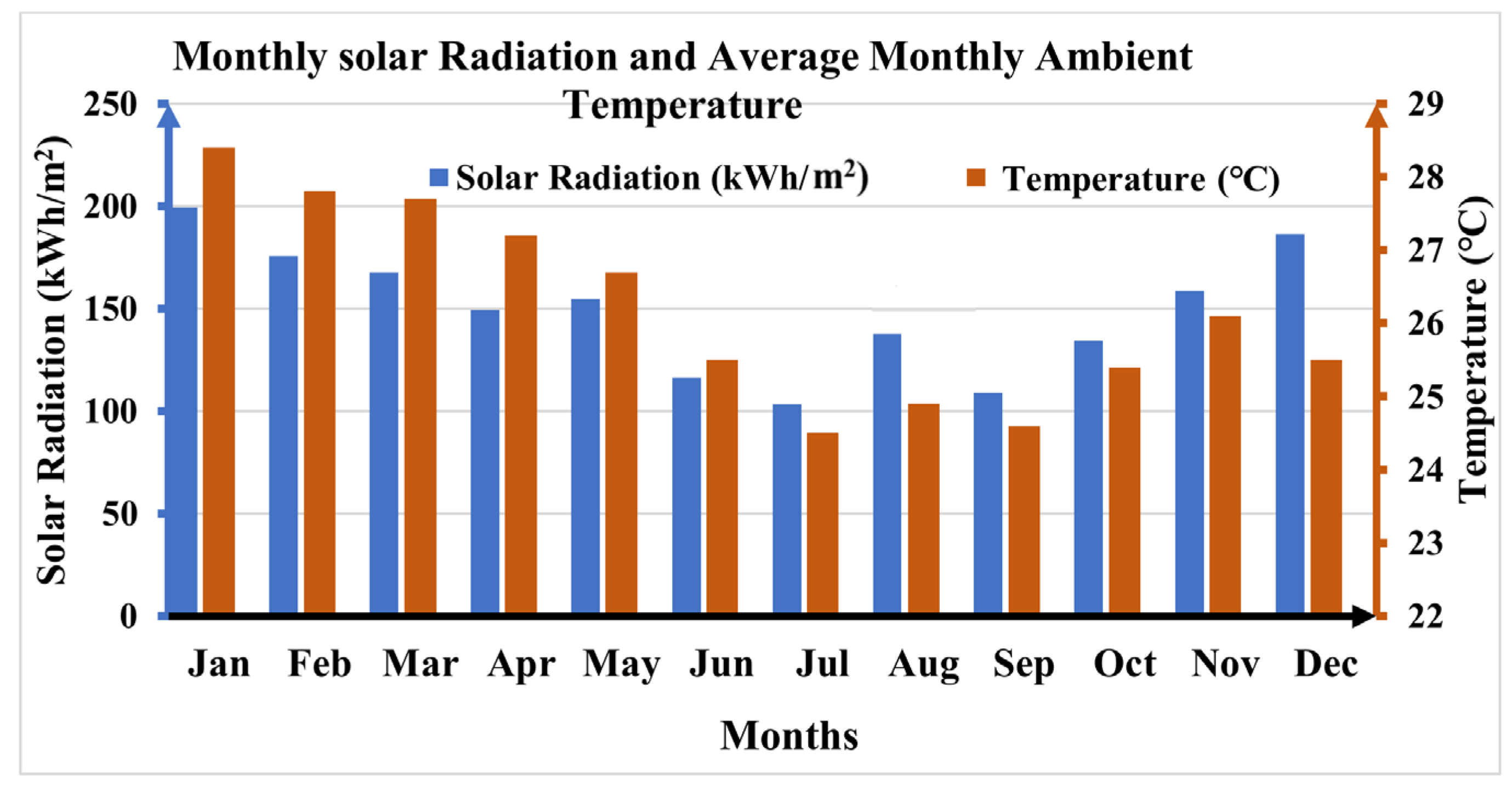


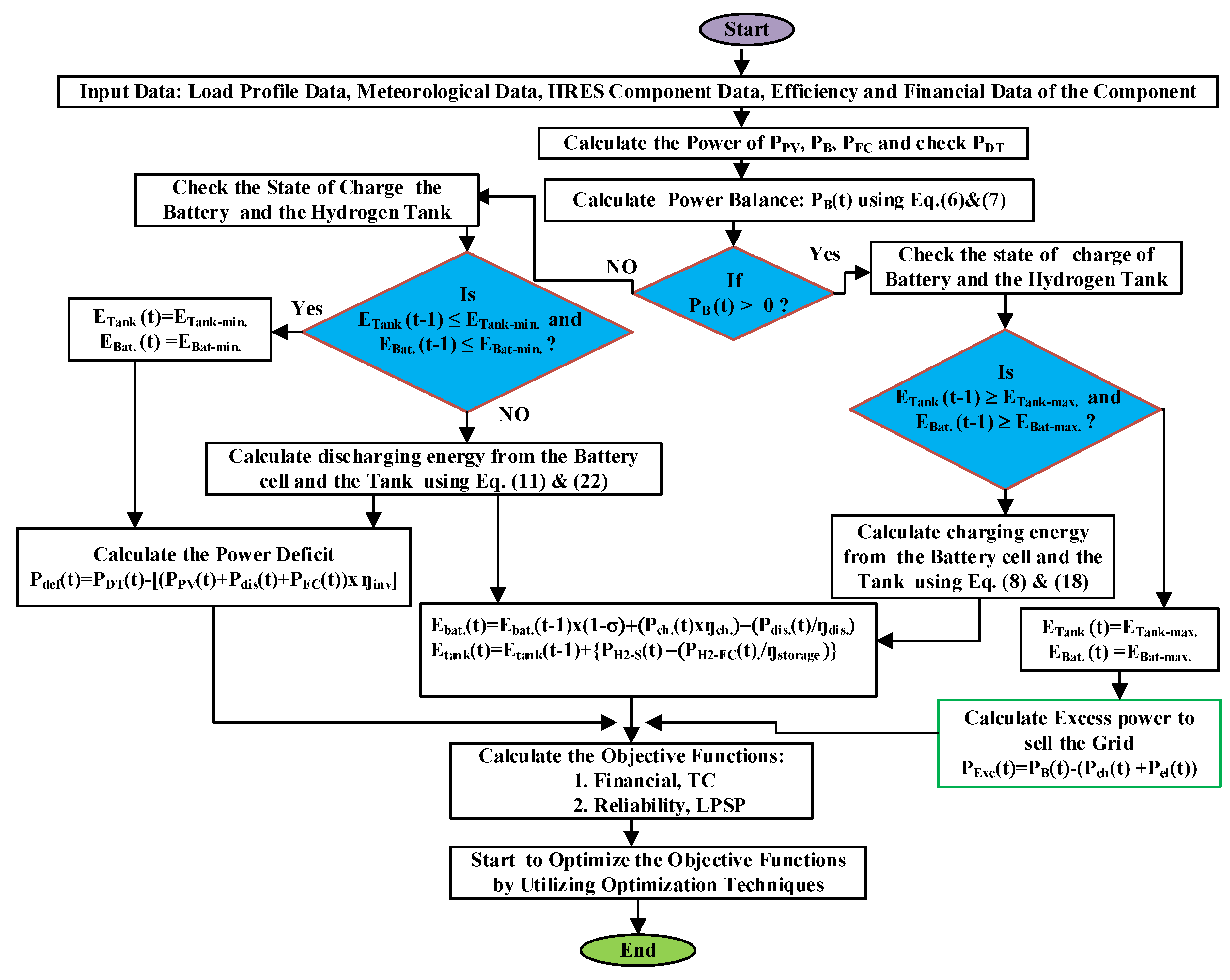

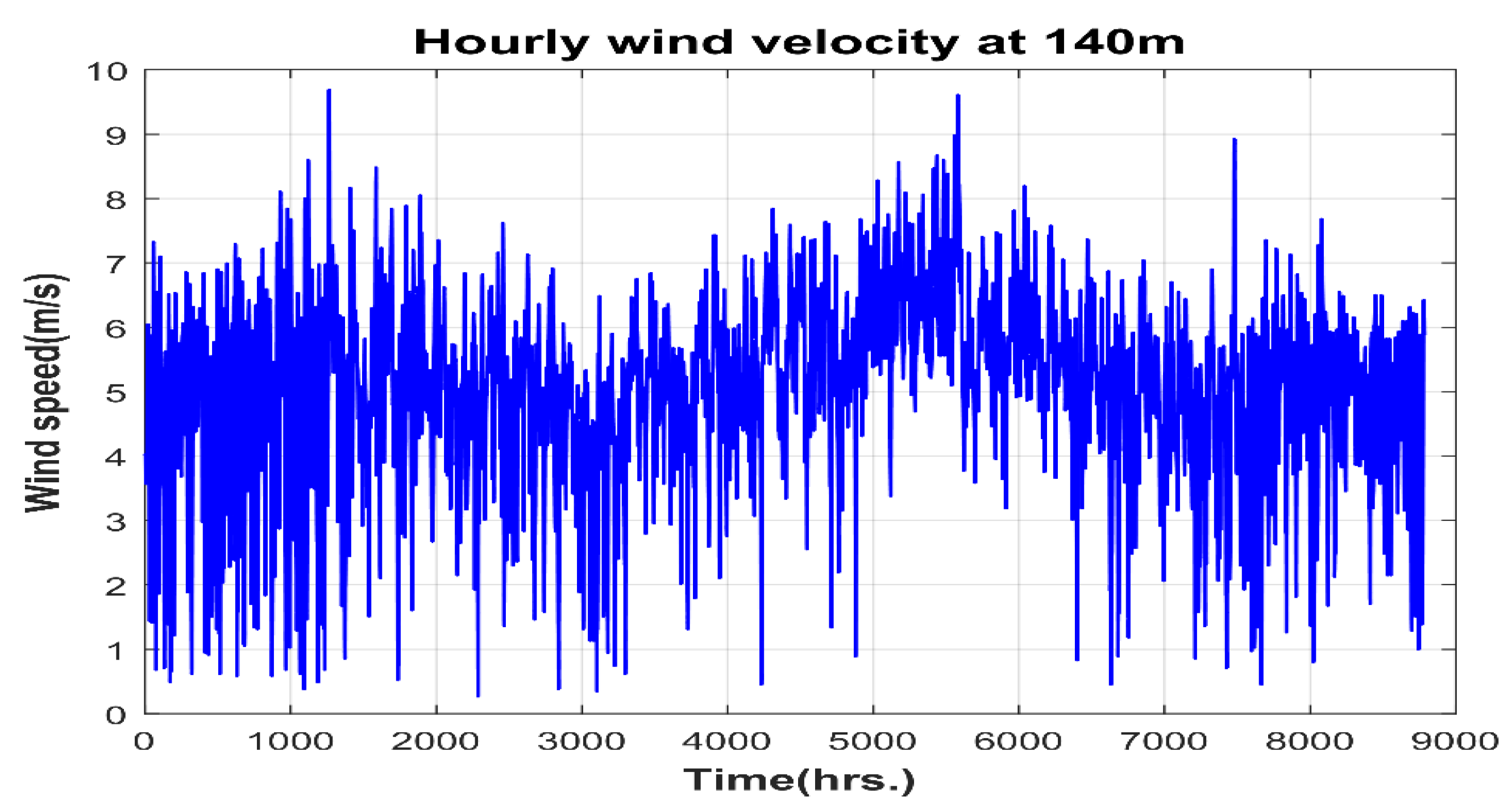
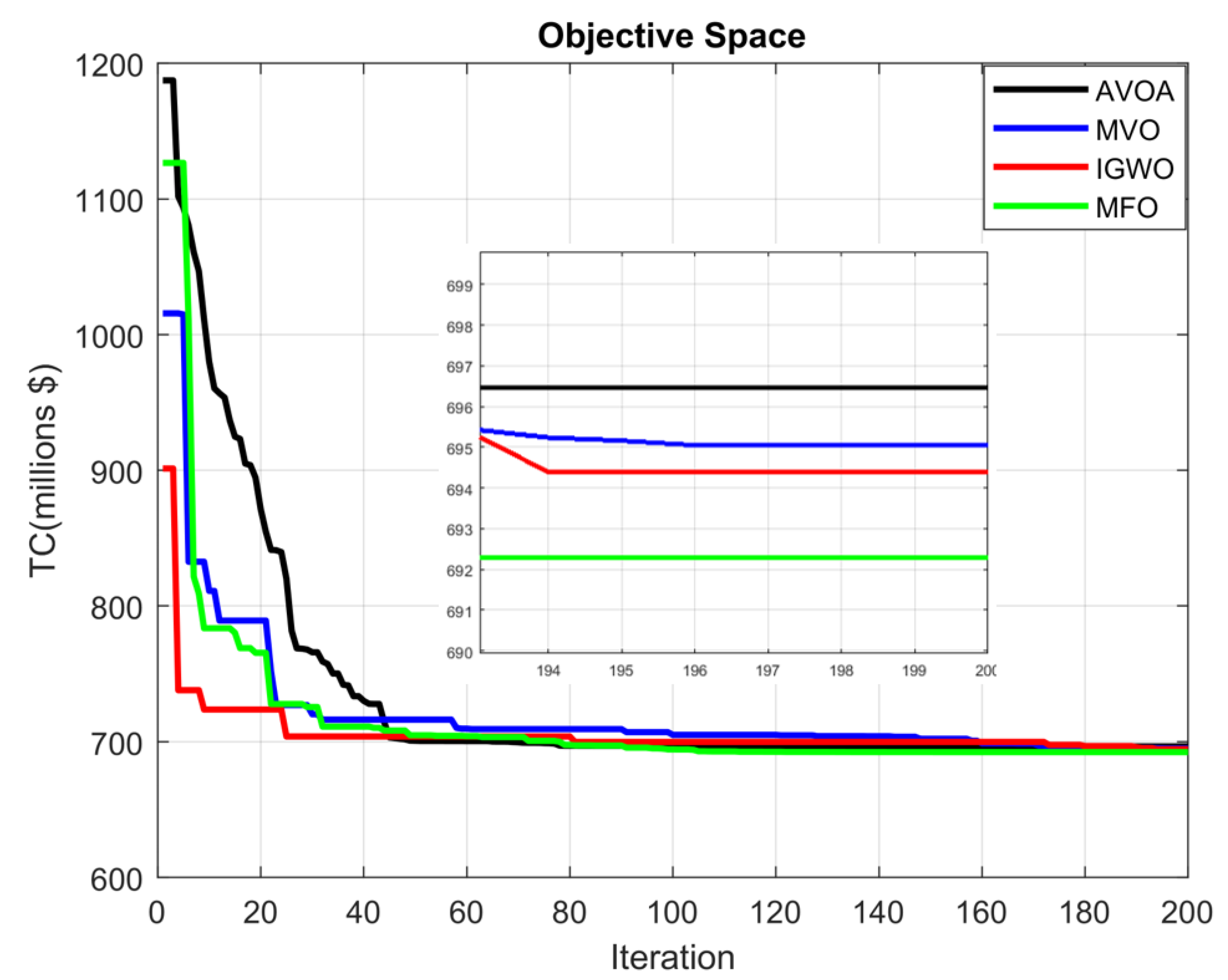


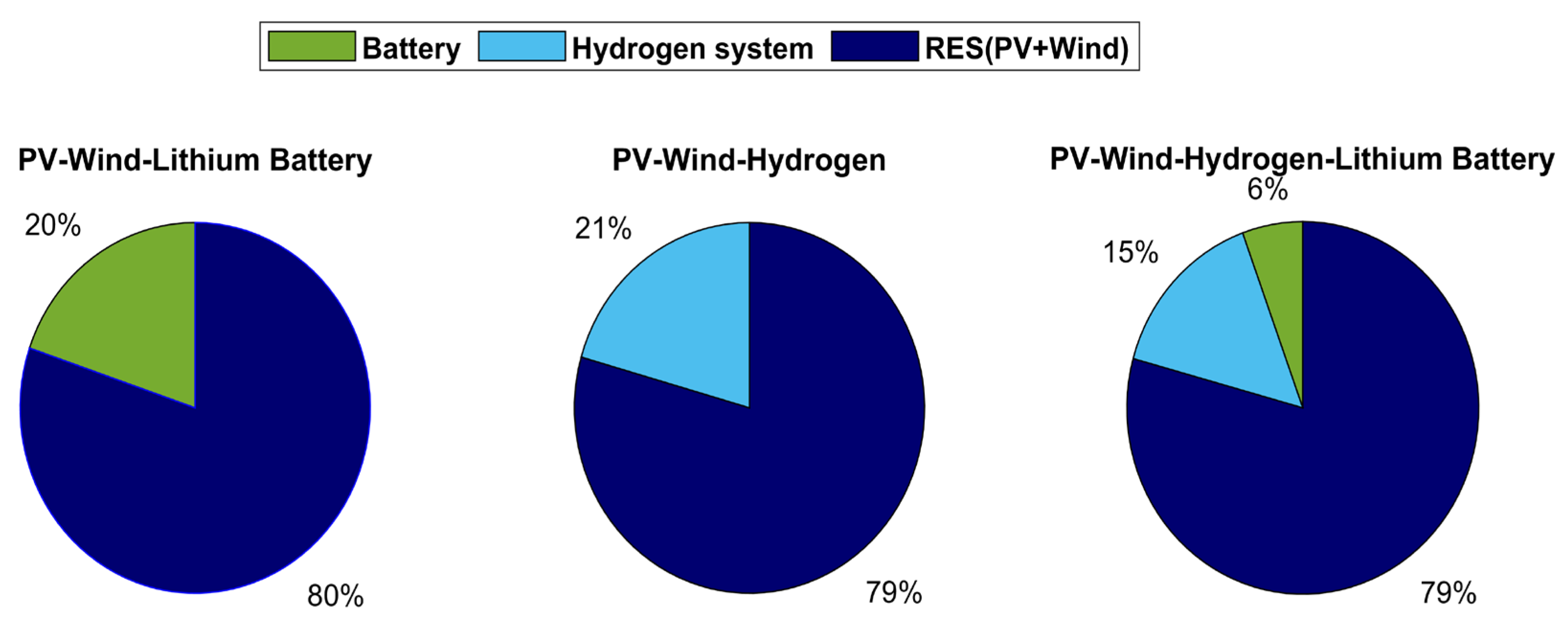

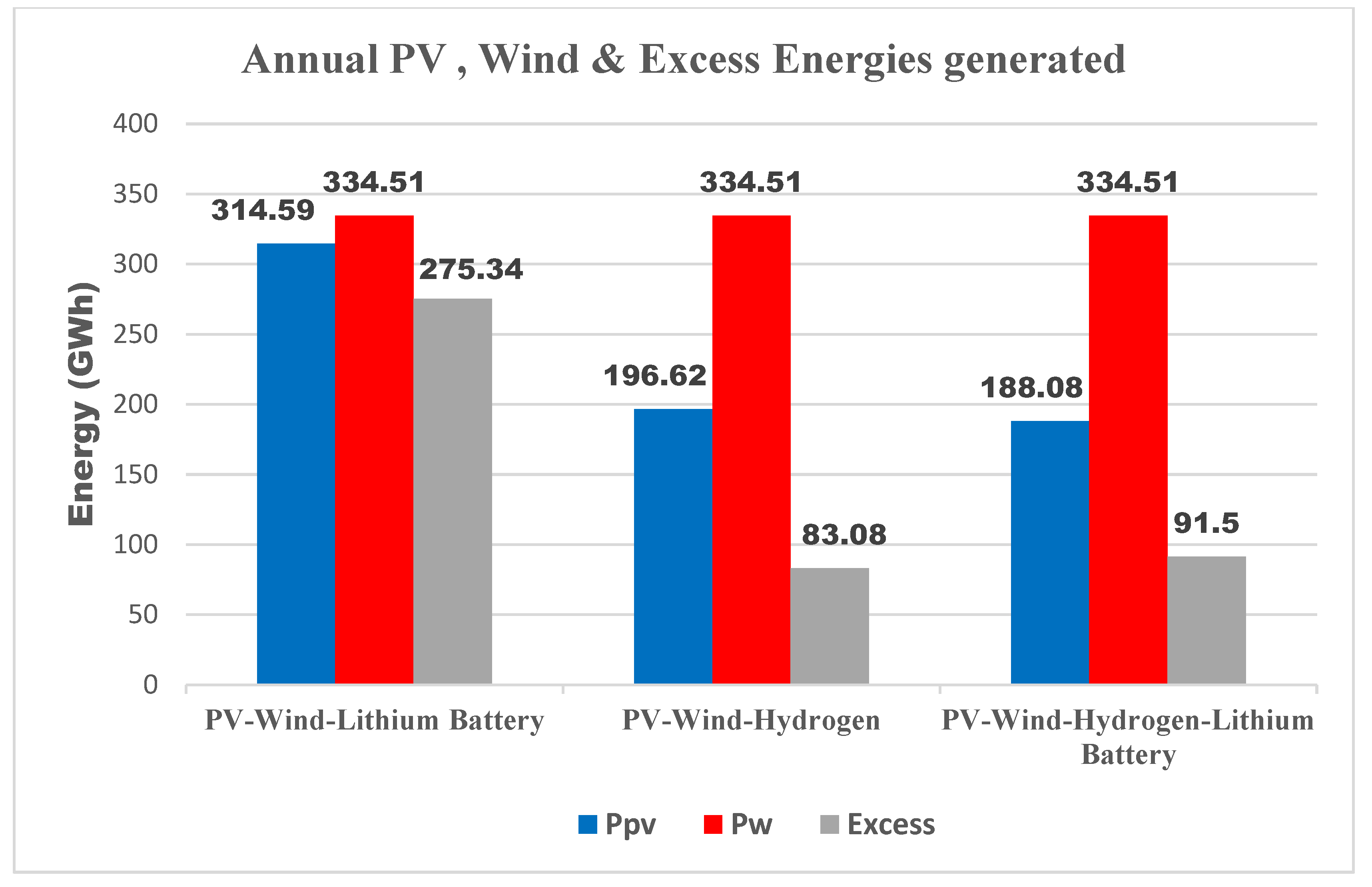



| Factors | MFO | I-GWO | MVO | AVOA |
|---|---|---|---|---|
| 0.0999 | 0.0994 | 0.0999885 | 0.0999 | |
| 692,291,975.224 | 694,525,861.46 | 695,049,204.50 | 696,664,074.77 | |
| 129.14 | 129.05 | 129.16 | 131.45 | |
| 135 | 135 | 135 | 132 | |
| 106.80 | 85.384 | 79 | 95.13 | |
| 63.20 | 66.51 | 69.23 | 67.55 | |
| 81.91 | 83.46 | 82.54 | 83.69 | |
| 105,802 | 110,518.77 | 110,330 | 112,996.20 | |
| 130.74 | 130.65 | 130.77 | 133.08 |
| Factors | Lithium Battery | Hydrogen | Lithium Battery-Hydrogen |
|---|---|---|---|
| 0.0999 | 0.0999 | 0.0999 | |
| 816,123,339.58 | 708,918,245.46 | 692,291,975.22 | |
| 216 | 135 | 129.14 | |
| 135 | 135 | 135 | |
| 974.053 | 0 | 106.80 | |
| 0 | 79.59 | 63.20 | |
| 0 | 88.29 | 81.91 | |
| 0 | 120,417.59 | 105,802 | |
| 218.68 | 136.68 | 130.74 |
Disclaimer/Publisher’s Note: The statements, opinions and data contained in all publications are solely those of the individual author(s) and contributor(s) and not of MDPI and/or the editor(s). MDPI and/or the editor(s) disclaim responsibility for any injury to people or property resulting from any ideas, methods, instructions or products referred to in the content. |
© 2023 by the authors. Licensee MDPI, Basel, Switzerland. This article is an open access article distributed under the terms and conditions of the Creative Commons Attribution (CC BY) license (https://creativecommons.org/licenses/by/4.0/).
Share and Cite
Amoussou, I.; Tanyi, E.; Fatma, L.; Agajie, T.F.; Boulkaibet, I.; Khezami, N.; Ali, A.; Khan, B. The Optimal Design of a Hybrid Solar PV/Wind/Hydrogen/Lithium Battery for the Replacement of a Heavy Fuel Oil Thermal Power Plant. Sustainability 2023, 15, 11510. https://doi.org/10.3390/su151511510
Amoussou I, Tanyi E, Fatma L, Agajie TF, Boulkaibet I, Khezami N, Ali A, Khan B. The Optimal Design of a Hybrid Solar PV/Wind/Hydrogen/Lithium Battery for the Replacement of a Heavy Fuel Oil Thermal Power Plant. Sustainability. 2023; 15(15):11510. https://doi.org/10.3390/su151511510
Chicago/Turabian StyleAmoussou, Isaac, Emmanuel Tanyi, Lajmi Fatma, Takele Ferede Agajie, Ilyes Boulkaibet, Nadhira Khezami, Ahmed Ali, and Baseem Khan. 2023. "The Optimal Design of a Hybrid Solar PV/Wind/Hydrogen/Lithium Battery for the Replacement of a Heavy Fuel Oil Thermal Power Plant" Sustainability 15, no. 15: 11510. https://doi.org/10.3390/su151511510
APA StyleAmoussou, I., Tanyi, E., Fatma, L., Agajie, T. F., Boulkaibet, I., Khezami, N., Ali, A., & Khan, B. (2023). The Optimal Design of a Hybrid Solar PV/Wind/Hydrogen/Lithium Battery for the Replacement of a Heavy Fuel Oil Thermal Power Plant. Sustainability, 15(15), 11510. https://doi.org/10.3390/su151511510










